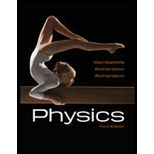
Concept explainers
(a)
The image distance and characteristics of the image.
(a)
Answer to Problem 72P
The image distance and characteristics of the images is given in table 1.
Explanation of Solution
Write an expression for lens’ law.
Here,
Rearrange equation (I) to find
Write an expression for magnification.
Here,
If the magnification is positive, the image is virtual and upright. If the magnification is negative the image is real and inverted. If the magnification is greater than one, the image is larger than the object. If the magnification is less than one, the image is smaller than the object.
Conclusion:
For object distance
Substitute
Substitute
For object distance
Substitute
Substitute
For object distance
Substitute
Substitute
For object distance
Substitute
Substitute
For object distance
Substitute
Substitute
Thus, the image distance and characteristics of the images is given in table 1.
| Real or virtual | Orientation | Relative size | |||
| Virtual | Upright | Diminished | |||
| Virtual | Upright | Diminished | |||
| Virtual | Upright | Diminished | |||
| Virtual | Upright | Diminished | |||
| Virtual | Upright | Diminished |
Table 1
(b)
The height of the image.
(b)
Answer to Problem 72P
The height of the image at
Explanation of Solution
Write an expression for the image height.
Here,
Conclusion:
For object distance
Substitute
For object distance
Substitute
Thus, the height of the image at
Want to see more full solutions like this?
Chapter 23 Solutions
Physics
 College PhysicsPhysicsISBN:9781305952300Author:Raymond A. Serway, Chris VuillePublisher:Cengage Learning
College PhysicsPhysicsISBN:9781305952300Author:Raymond A. Serway, Chris VuillePublisher:Cengage Learning University Physics (14th Edition)PhysicsISBN:9780133969290Author:Hugh D. Young, Roger A. FreedmanPublisher:PEARSON
University Physics (14th Edition)PhysicsISBN:9780133969290Author:Hugh D. Young, Roger A. FreedmanPublisher:PEARSON Introduction To Quantum MechanicsPhysicsISBN:9781107189638Author:Griffiths, David J., Schroeter, Darrell F.Publisher:Cambridge University Press
Introduction To Quantum MechanicsPhysicsISBN:9781107189638Author:Griffiths, David J., Schroeter, Darrell F.Publisher:Cambridge University Press Physics for Scientists and EngineersPhysicsISBN:9781337553278Author:Raymond A. Serway, John W. JewettPublisher:Cengage Learning
Physics for Scientists and EngineersPhysicsISBN:9781337553278Author:Raymond A. Serway, John W. JewettPublisher:Cengage Learning Lecture- Tutorials for Introductory AstronomyPhysicsISBN:9780321820464Author:Edward E. Prather, Tim P. Slater, Jeff P. Adams, Gina BrissendenPublisher:Addison-Wesley
Lecture- Tutorials for Introductory AstronomyPhysicsISBN:9780321820464Author:Edward E. Prather, Tim P. Slater, Jeff P. Adams, Gina BrissendenPublisher:Addison-Wesley College Physics: A Strategic Approach (4th Editio...PhysicsISBN:9780134609034Author:Randall D. Knight (Professor Emeritus), Brian Jones, Stuart FieldPublisher:PEARSON
College Physics: A Strategic Approach (4th Editio...PhysicsISBN:9780134609034Author:Randall D. Knight (Professor Emeritus), Brian Jones, Stuart FieldPublisher:PEARSON





